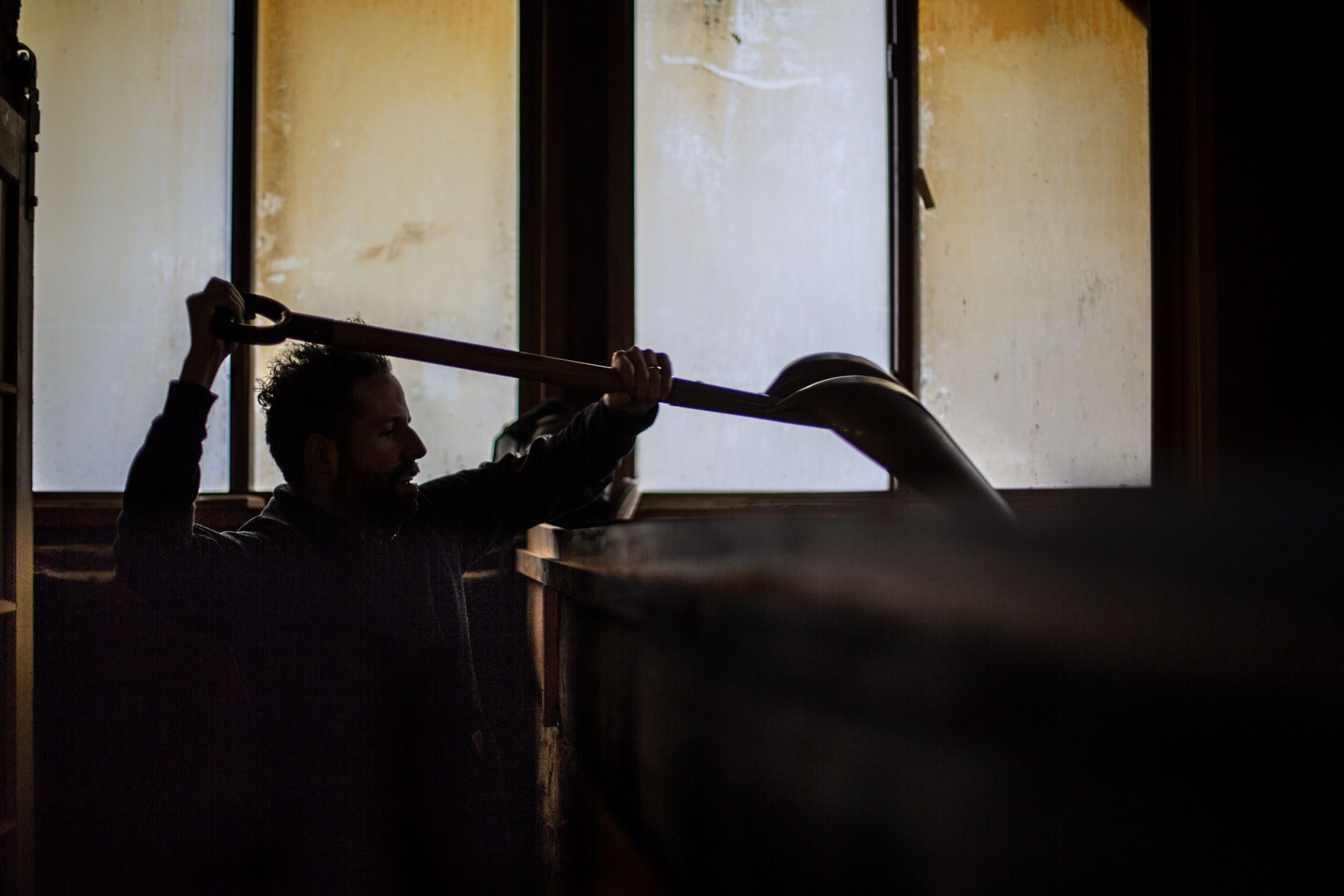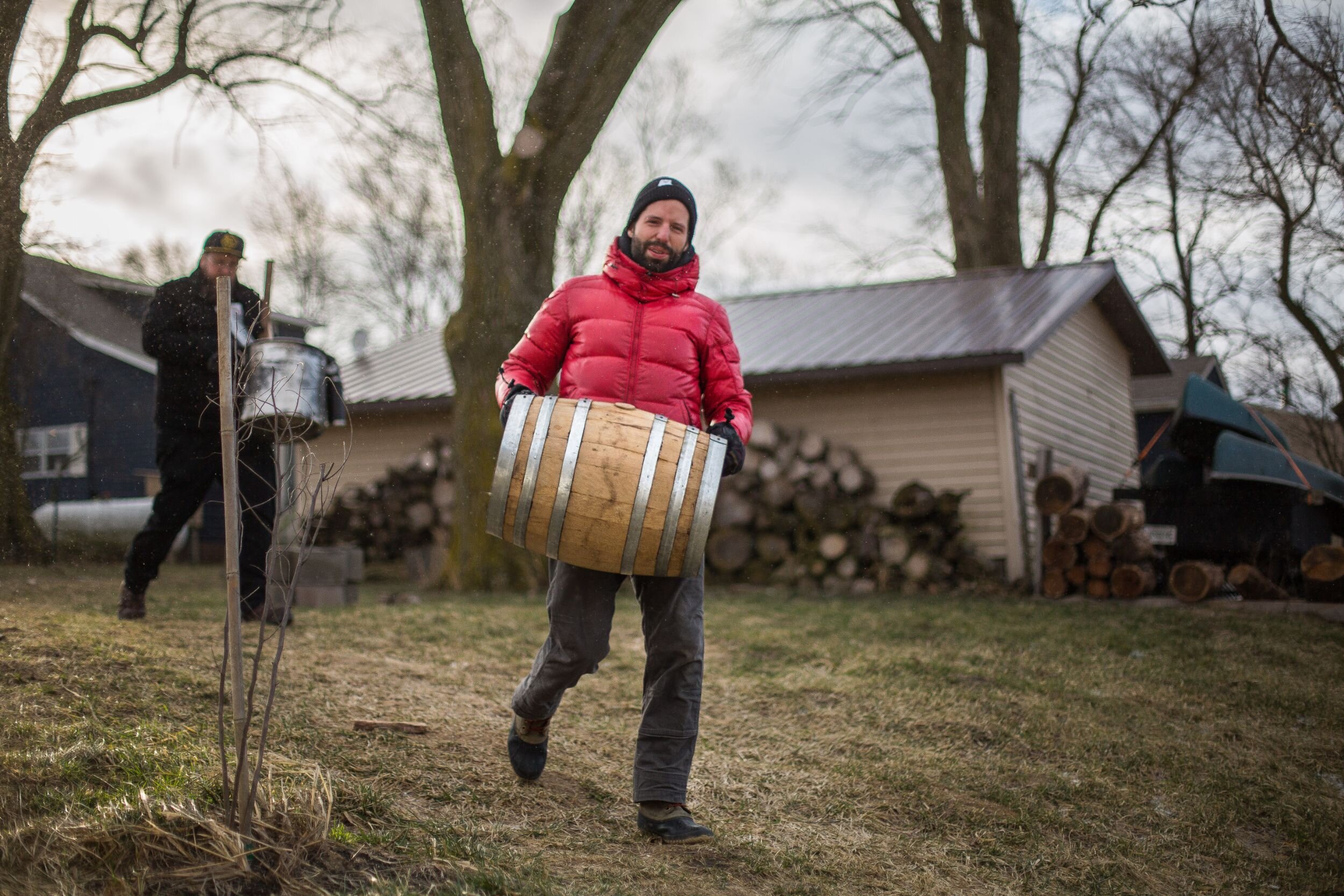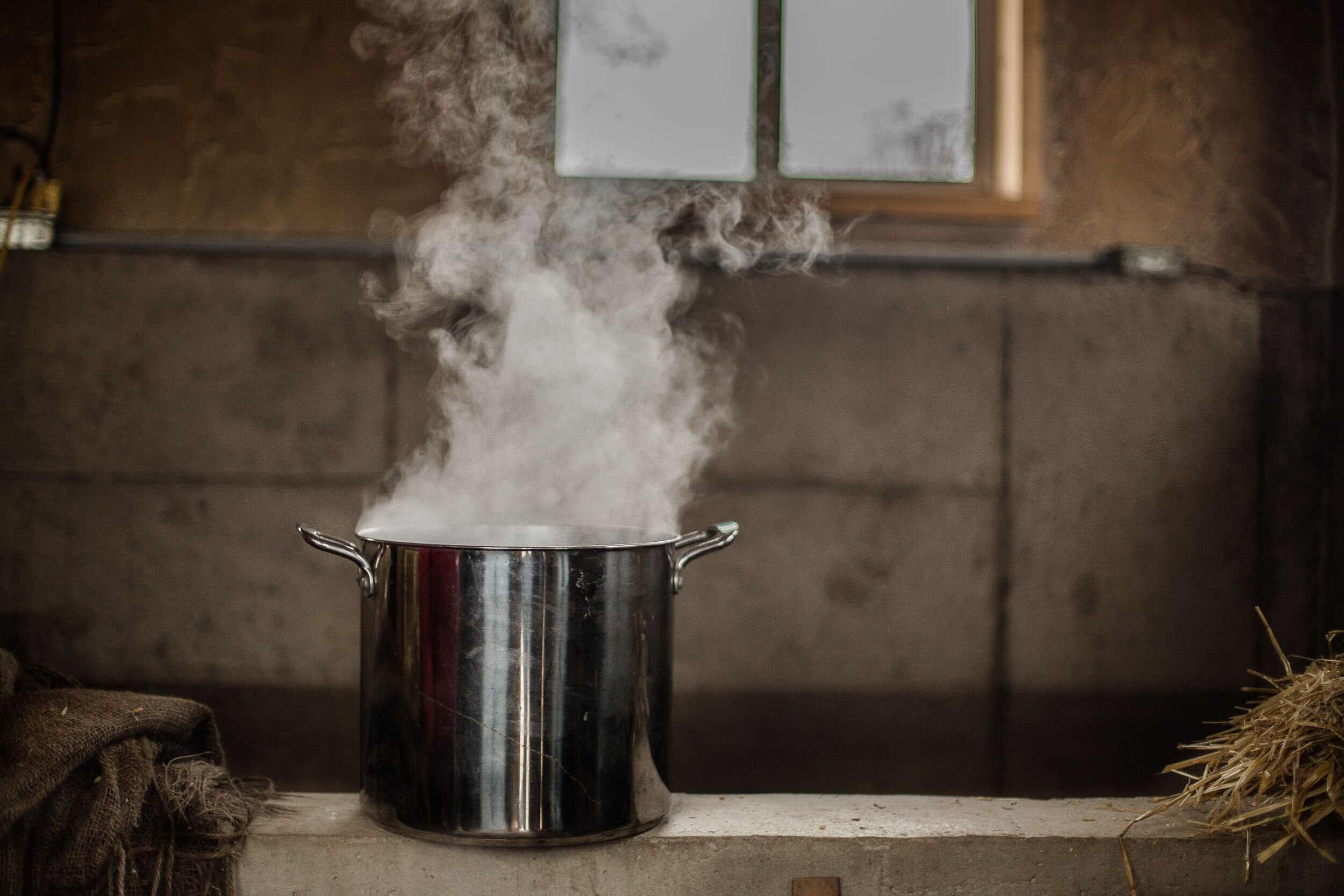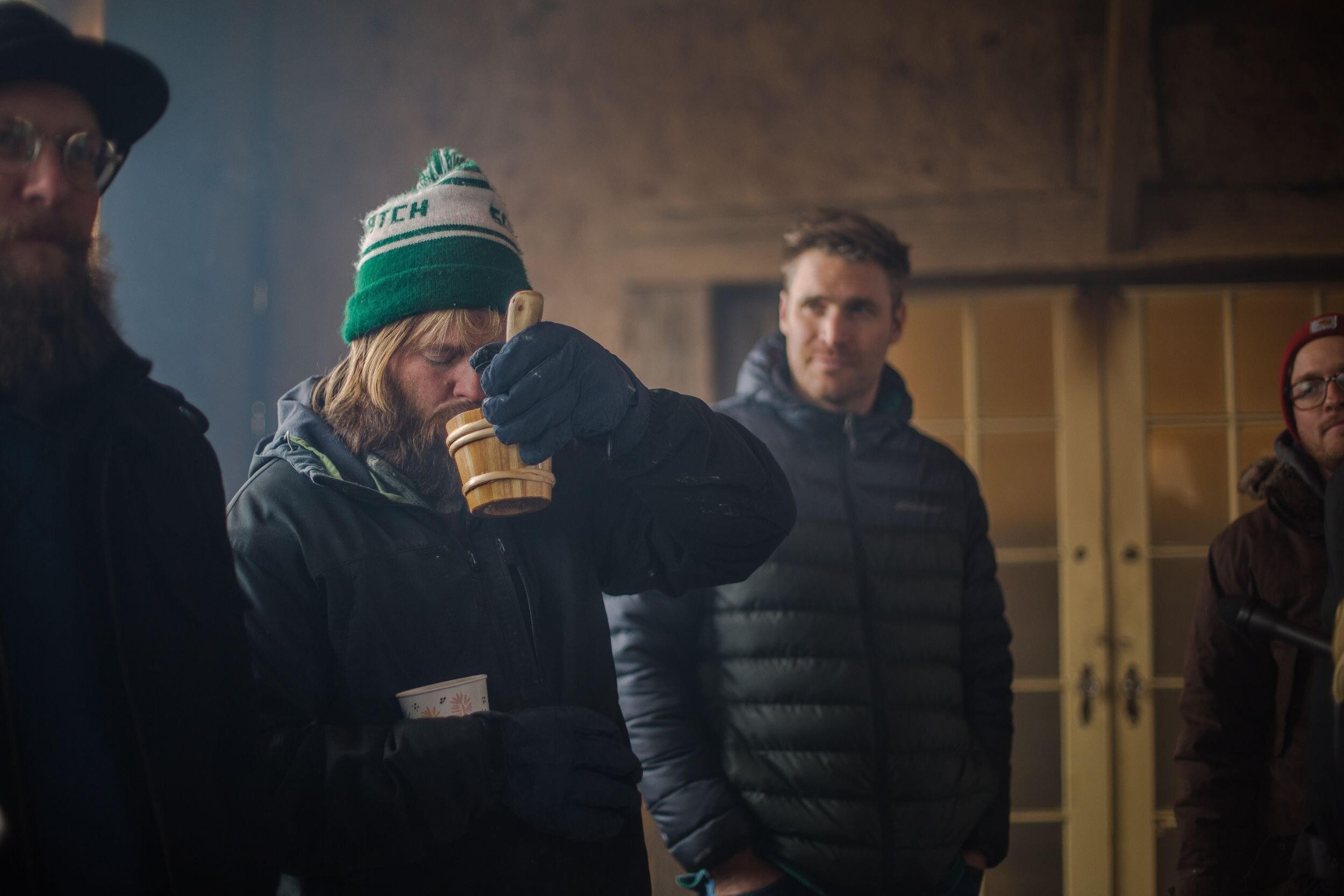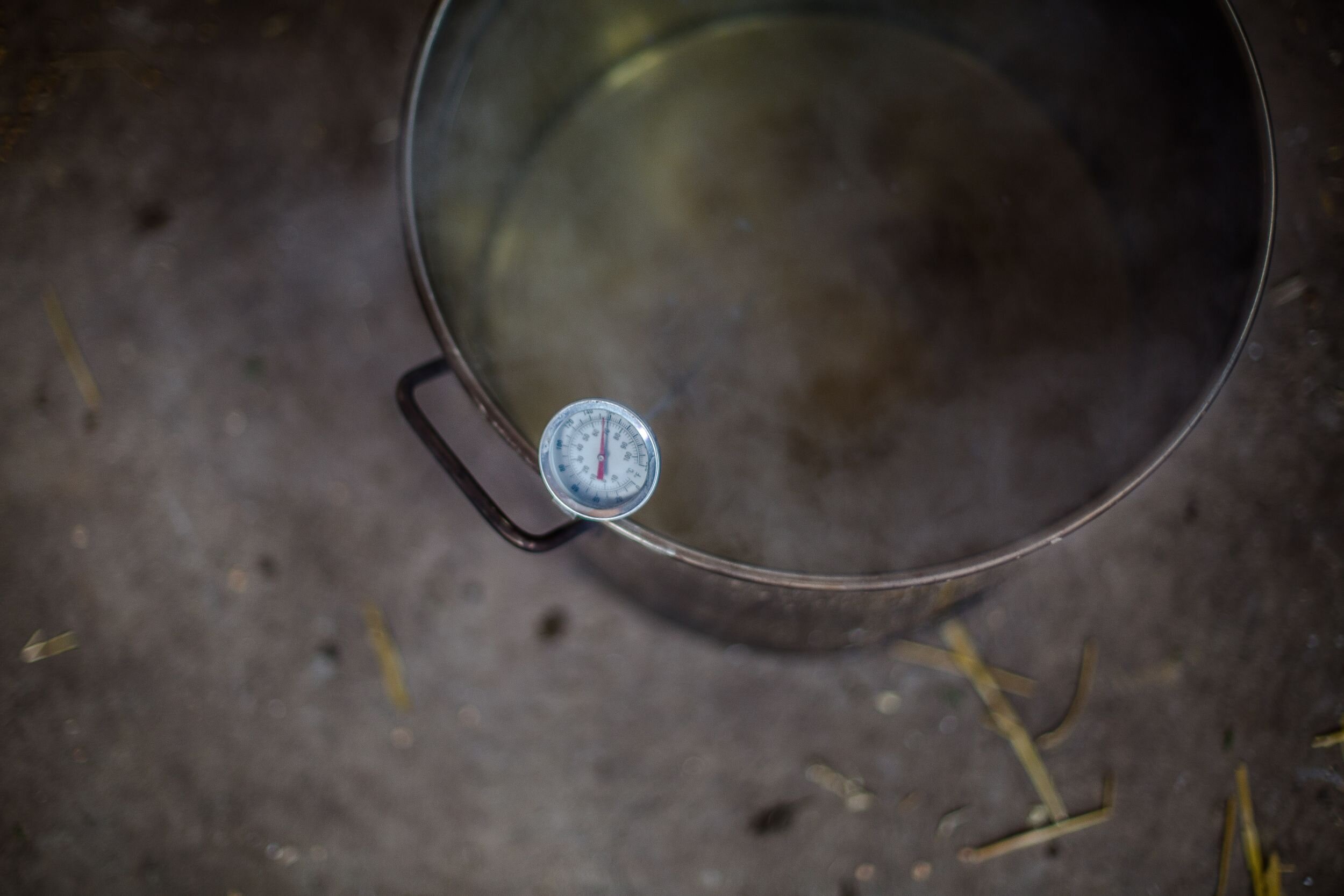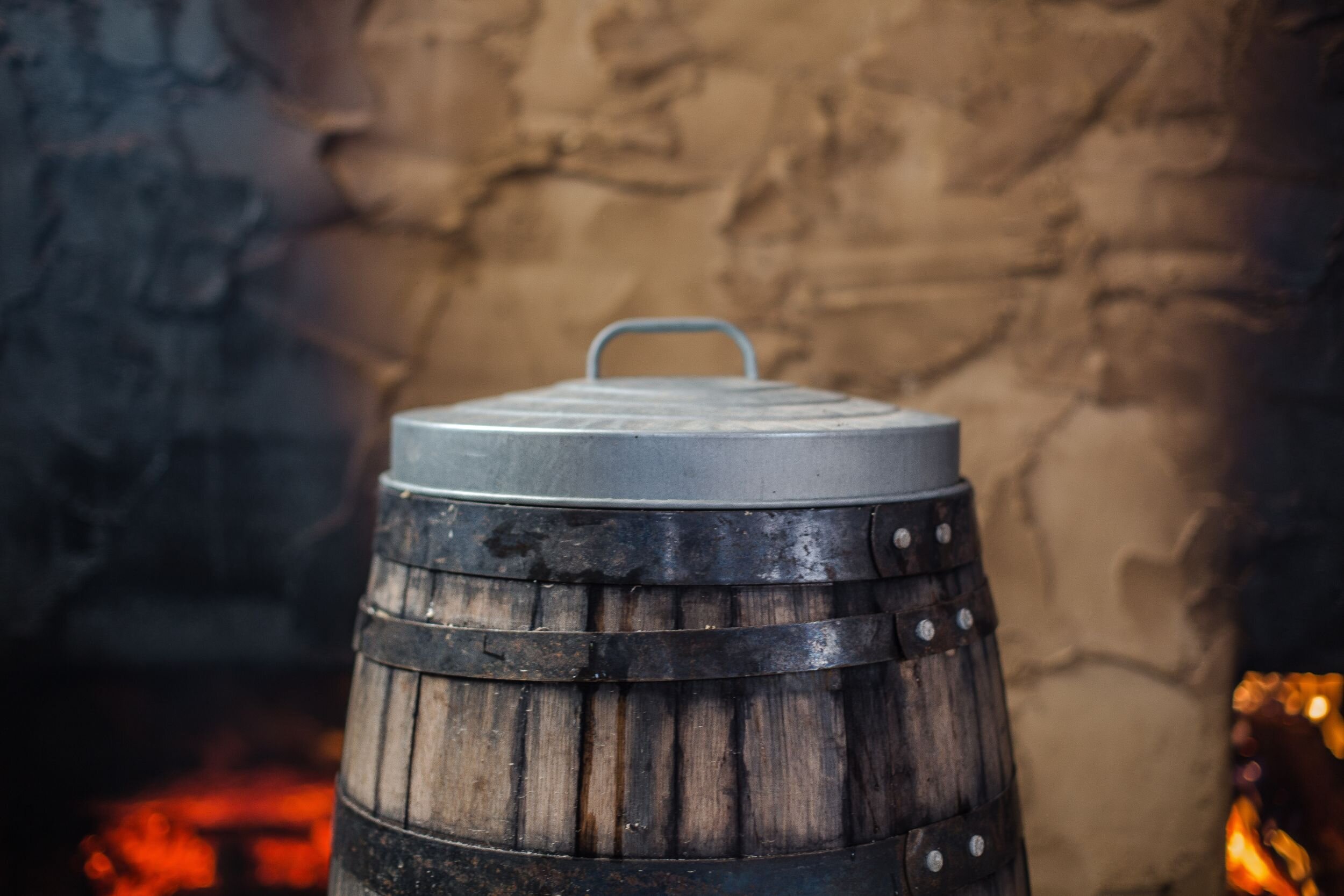I’d been wanting to visit Sugar Creek Malt Company ever since I heard about its owner, Caleb Michalke, and his desire to open a såinnhus—a malt house traditionally used in Norway—on his property in rural Indiana. There aren’t exactly a lot of people in the Midwest invested in recreating small-batch, Nordic malting techniques in isolated bank barns. Especially not in the dead of winter.
Michalke had researched opening a malt shop in 2014 before deciding to launch Sugar Creek in 2015. At the time there were some 12 micro-maltsters in North America, he estimates. That number now, he figures, is closer to 160. Craft malting has taken longer to gain steam in the beer world compared to the rapid ascent of specialty hops, but it is beginning to carve out a place in the industry.
The recent growth of small-scale maltsters has brought with it a number of malting innovations, many of which are concerned with consistency and overall product quality. But while independent operations have focused on cutting-edge technology, Michalke has conversely looked to the past. His såinnhus is the first step towards reproducing time-lost ales, made the old way, using ancient techniques most would not recognize.
Finally, the opportunity arose to plan a trip to Sugar Creek, alongside a number of curious brewers. Marika Josephson and Aaron Kleidon of Scratch Brewing Company in Ava, Illinois; Tim Gormley from Burial Beer Co. in Asheville, North Carolina; and Jonny Ifergan, Ryan Sanders, and Briana Hestad of Ørkenoy, an upstart brewery set to open in Chicago late this summer, all jumped in on an email chain with ideas and suggestions for our brew day.
I’m not ashamed to admit I had to Google several of the words being thrown around. My unfamiliarity with traditional Scandinavian brewing only added to my amazement at the ancestral ingenuity on display. It became clear, even before visiting, how special Michalke’s såinnhus will be for those looking to venture outside the safe confines of the IPA-dominated beer scene.
On a mild, rainy afternoon, I make the three-hour drive from Chicago to Indianapolis International Airport to scoop up GBH’s creative director, Michael Kiser, fresh off a plane from London. After doubling back east to Lebanon, Indiana, we pull up to Sugar Creek.
The scenery is what you’d expect from Indiana: the malt house is surrounded by fields stretching to the horizon, with distant farmhouses providing the only topographical disturbance amidst the crops. We’re the last of the bunch to arrive before Michalke takes us on a short tour of the malting operation that sits adjacent to his home.
Sugar Creek is malting barley mainly sourced from Kentucky, as the grain isn’t generally suited to Midwestern weather. This changes depending on the weather. Recent wild fluctuations in temperatures have made it harder than ever to produce local barley of consistent quality, and area farmers, including Michalke’s own father, have struggled with the impacts of the changing climate.
“It's difficult for farmers to make quality for us, especially growing here in the Midwest,” Michalke explains. “Even if they have a good crop, if it's too high in protein or it has mold or fungus or whatever it is, we'll reject it or it'll go to feed. If I reject it two years in a row, they usually don't want to do it after that.”
Not all of Michalke’s malts are experimental, or harken back to Old World techniques. Sugar Creek’s production malthouse, which turns out about 7 batches (21,000 lbs) per week, is responsible for more than half that total in base malts. Michalke has a roaster running five days a week for crystal and chocolate malts with a couple batches currently coming from the såinnhus, which is where we’re headed next.
Typically, såinn-style kilns are built over a stone fireplace, with openings on either side. On top, planks are laid to make the bed and sides, punctured with thousands of hand-drilled holes to allow the heat and smoke to filter through the grains. After reading about the method years ago, Michalke became enamored by the opportunity to offer a product and experience no one else in the area could match—and to recreate malts that would allow brewers to truly emulate Nordic and other regional beer styles.
“To go back and brew a Nordic beer and use modern malt, you can never really recreate those flavors because it's not what the beer actually tasted like,” says Michalke. “I wanted to be able to produce something no one else was producing.”
He jumped online, found some folks in Norway that malt on a såinn, and began to gather information to build his own. In 2018, Michalke started the process, building into the hillside just steps from his house, using salvaged wood from his grandfather’s farm.
We all pile inside seeking refuge from the intense mix of wind, rain, and mud that persists throughout the afternoon. It’s a cozy but brief escape, as we’ll soon be put to work.
Once inside, Michalke begins moving sacks of water-logged grain from a cement tank in the corner of the såinnhus. Each of us takes turns unraveling the twine and pouring the steeped grains on the cement floor, spreading them evenly until they’re level, and about six inches deep. In a few days, he says, they’ll be placed in the såinn bed to interrupt germination, where they’ll be dried for 16-24 hours.
“To go back and brew a Nordic beer and use modern malt, you can never really recreate those flavors because it’s not what the beer actually tasted like. I wanted to be able to produce something no one else was producing.”
Thankfully, Michalke has another batch that’s ready for the såinn on the opposite wall, so we can take part in the process. We each take turns shoveling the grain from the floor into the såinn to be smoked the next day. We’re maltsters now.
After a half hour’s worth of honest work, we head back to the house for dinner. Josephson and Kleidon come to the table with a few small growlers of Scratch beer with paper tags; one, marked “oven beer,” is a preview of the Keptìnis—or Lithuanian-style farmhouse beer made from oven-baked malt, often shaped in loaf pans—we’ll be brewing the next day.
The beer—technically a Pilsner—is deep amber owing to the baked malt, and has an unexpectedly juicy, estery, even apple-like flavor. It’s unlike anything I’ve ever had, and it’s hard to believe it’s a Lager.
The second beer we’re treated to is Scratch’s collaboration with Jester King Brewery, Bière De Pêche. It drinks as if brewed with peaches itself, but was instead made with peach leaves, plus lemon balm and juniper; again, it’s remarkable in terms of flavor and technique. To round out these special offerings, Gormley offers some of Burial’s rock-solid staples: a Dark Lager, a Pilsner, and an American Pale Ale.
Our glasses full, we’re ready to dive into a stick-to-your bones farmhouse meal of fried chicken, asparagus, mashed potatoes, gravy, and cornbread, all courtesy of Michalke’s wife, Whitney. We are spoiled.
After dinner we linger at the table, passing bottles and talking about malting: how the ability to continually experiment is what drew Michalke to the world of malt, how little information and education there is available on malting, how under-represented malt is in the brewing process and how the relationships he makes with brewers are truly the best part of what he does.
“Have you ever had dinner with the Briess dude?” Michalke jokes as he disappears and returns with jars containing some of his specialty malts. There’s Crystal Rye; Stjørdal (a Norwegian-inspired two-row barley, smoked over alder wood with a bit of heat applied, giving it a deep-red hue); and something he calls “Indiana Nordic,” a blend of floor-germinated barley dried over cherry and birchwood.
We pass the jars around, burying our noses in them, tasting the grains and taking turns oohing and aahing over their incredible fragrances and flavors. I wish all the hop obsessives who think malt is boring could smell and taste Michalke’s products for themselves.
“[We talk about] how the ability to continually experiment is what drew Michalke to the world of malt, how little information and education there is available on malting, how under-represented malt is in the brewing process, and how the relationships he makes with brewers are truly the best part of what he does.”
It’s getting late, but there is a small bit of prep to be done before tomorrow’s brew day. Josephson disappears to the kitchen where I find her mixing a slurry of water and flour into her starter culture, which will be pitched in one of the beers. Once she wraps up, we give the Michalkes their house back for the evening, and head to our Airbnb.
We wake in the morning to a harsh temperature swing, from mild, muddy, and rainy to a your-digits-are-in-danger type of cold. The ground is frozen, wind chills are slated to reach -30°F, and we’re supposed to brew beer outdoors. It’s almost as if the Norse gods are calling in a favor from Mother Nature to replicate a truly Nordic brew day experience.
When we arrive at the malt house, Michalke is already hard at work lighting the fire in the såinnhus and stoking another in the makeshift “oven” outside. We balk at standing out in the elements during the brewing process before Michalke relents and tells us he thinks he knows a way we can brew in the såinnhus instead. We collectively exhale a sigh of relief, and warm up with biscuits and gravy before we get to work.
Post-breakfast, we begin to gather tools—cinder blocks and wood planks, barrels and stock pots—to fashion a brew station, and chop wood for the fires in both the outdoor oven and the såinnhus. Then, unusually, we gather rocks—lots and lots of granite rocks—to be baked in the oven. They’ll later be added to our wort to help it maintain a steady boil.
Our Keptìnis, Michalke tells us, will be made with 100% Sugar Creek Pilsner malt and a handful of caraway seeds for good measure. We’ll prepare a separate hop tea, made using whole Cascade hops and bog myrtle leaves. The day’s second brew, a stein beer, will feature 100% Stjørdal malt; a variety of hop that no one seems to remember (some things are more fun when they’re a mystery); as well as hay, straw, and juniper branches plucked from their roots just outside the såinnhus.
We start with the Keptìnis by heating a pot of water in the oven, pouring it into a barrel, adding the Pilsner malt, and letting it sit with a lid on, warm near the fire from the såinn.
Next, we transport the now-baked stones from the fire to our brew station, and start the process for the stein beer by making a bed in the barrel using the hay, straw, and juniper. We place the hot stones on top and add water and Stjørdal malt to mash in. Now we wait, which means retreating to the warmth of the house for the time being.
It is time to bake the malt for the Keptìnis, and so we emerge from the house with several of Whitney’s pans. The lid comes off the barrel and we take turns scooping the mash into the pans, delighting at the plopping noises it makes, before we each grab a pan and head outside to nestle them over the oven’s flame. The malt will slowly bake this way over the course of three hours.
We all head back to the såinnhus where Michalke drills a hole in the bottom of the stein barrel to drain into a metal keg as Josephson takes the lead during the lauter.
In search of warmth while we brew, even if artificial, Ifergan asks if any whiskey made from Sugar Creek malts might be floating around. Michalke disappears and returns with three bottles. We take turns sampling each, straight. We then do what any brewer would do and pull some of the wort while lautering and mix it with the liquor to create what Scandinavians call “lännähalva.” You might know it as a “hot scotchy.” It works—we’re all suddenly feeling a lot better about the cold.
We break for a lunch of chicken and wild rice soup, biscuits and salad. More Scratch beer makes the rounds. This time we’re treated to two beers from the brewery’s Mushroom Series: Hen of the Woods, a farmhouse Blonde Ale made with maitake mushrooms, oak leaves, Illinois-grown wheat, and smoked malt; and Oyster Weiss, a Berliner Weiss made with oyster mushrooms and bittered with turmeric instead of hops.
The former is funky with a musty umami character; the latter is bright and acidic with an earthy undertone. The two beers are totally distinct, nuanced, and complex, and cause me to reconsider mushrooms as an ingredient in beer.
Ross Harding, owner of Hardwood Honey and Michalke’s friend, drops by and shares several of his own homebrewed meads. Similar to Scratch’s beer, all of Harding’s ferments are made using foraged plants—in this case, elderberry, echinacea, and burdock. The irony is not lost on us that, while Harding’s creations are completely grain-free, he’s still welcome in Michalke’s home.
We’re warm and full of food when it’s time to take the malt out of the oven. It has cooked a bit unevenly, with some pans more charred than others. The pans themselves appear to be a complete loss, but provide us with some workable grains worthy of a Keptìnis. Sorry, Whitney.
Back in the såinnhus, we scrape the malt from the pans and place it back in the barrel with hot sparge water added. Josephson again takes the lead on lautering, while Ifergan returns to the house to prepare the hop tea. The rest of us take turns with a ladle of liquor and wort. Since the malt is baked, no boil is needed. We place the barrel outside to cool.
“That is a beautiful thing. A room full of brewers and none of them are talking about hops. My job is done here.”
Gormley, the unofficial stone wrangler for the day, retrieves more granite stones from the oven to be added to the stein barrel for boiling. The rocks hiss and kick up an immense, satisfying amount of steam. Soon, the wort is boiling and stones are added periodically to keep temperatures up for about an hour. Hops are added, but no one remembers what kind.
“That is a beautiful thing,” says Michalke. “A room full of brewers and none of them are talking about hops. My job is done here.”
Wanting to impart a Nordic spirit to our boiling wort, Gormley pulls up some Nordic death metal on his phone and holds it up to the barrel. The vibes prove to be too much for our stone-handling tool—it breaks in two, leaving us with no way to remove the stones. We rack to a bucket moved outside to cool; that’s enough death metal for one day.
The bulk of the brew day is complete and it’s dinner time: Nordic mushroom stew over mashed potatoes with lingonberry jam on top, plus salad. It’s a recreation of a meal that Caleb and Whitney enjoyed on a trip to Norway a few years back. We are happy to indulge in their nostalgia while we wind down and thaw out.
Post-dinner, it’s time to pitch the yeast. Ifergan offers a packet of Kronjäst baker's yeast, brought back by a friend on their trip to Sweden.
Josephson retrieves her sourdough starter and mixes it into the stein, an experiment she’s been finetuning at Scratch for a while now. Knowing that the brewery would eventually serve bread and pizza, Josephson worked on a culture, made it healthy for bread, and then began thinking, as brewers do, “Why don’t we put this in beer?” They learned to scale from five gallons to two barrels, up to four and then eight. But its application in a commercial setting was still unknown.
“I’m thinking, are we literally going to pull a crusty mother culture out of our refrigerator, put it into a bucket, mix it with flour and water and dump it into our fermenter? What’s going to happen to our fermenter and all of our hoses?” Josephson says. “So … we did it.”
To amazing results, Josephson says. The methodology has created a “crazy, weird mixed culture” that they’ve learned to control. It’s the only yeast they pitch—their own house culture.
With the yeast pitched, we drink what’s left of the whiskey and share the last of the beers before the night winds down.
The drive home looms early the next morning. But before I worry about icy roads, I reflect on just how amazed I am by the people who contributed to the weekend. From the recipes and the process to the setting and the conversations shared, it was altogether a rare opportunity to experience ancient innovation made tangible. And it definitely made me appreciate the effort humans once went through just to get a good buzz.



